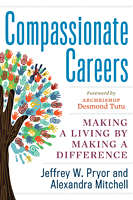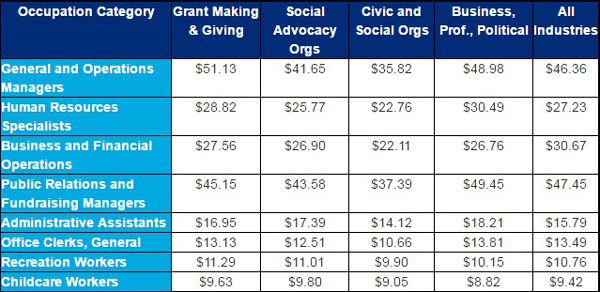If we don't refresh the face of civil society, we won't have a civil society.
Members of the Millennial Generation have eclipsed Baby Boomers in terms of size and job market saturation.[1] This huge demographic shift is no longer hypothetical and Millennials are quickly becoming an important talent pool for the nonprofit sector. Yet, attracting and retaining young talent today looks different than how we approached the Boomer generation. Millennials, those born in the early 80s to early 2000s, desire greater flexibility, a sense of purpose, and hope for meaningful impact in their work. To secure and retain this talent, the nonprofit sector needs to change how it attracts and develops its employees.
Young people are interested in meaningful careers, or what we call "compassionate careers," but many don't understand the nonprofit sector and are exceedingly hesitant about jobs within it. Why? Based on our research, three common barriers seem to be contributing.
Compassionate Careers: Making a Living by Making a Difference

Compassionate Careers is an inspirational guide to finding purpose-driven work and offers advice to anyone who feels that sitting on the sidelines is just not enough.
The Nonprofit Sector Is Undervalued as a Career Choice
Alternately called the not-for-profit sector, the third sector, the independent sector, the social sector, the for-benefit sector... we might as well call it the invisible sector, because family members, teachers, and counselors rarely present jobs in the sector as viable career choices.
In a broad study we at Pathfinder Solutions conducted with nearly 2,500 nonprofit and foundation professionals, just 4 percent said that anyone had mentioned nonprofit work as a possible career option. In another study we conducted across three states that involved thousands of young people, 25 percent couldn't name a single nonprofit.
Compensation Is Perceived as Too Low
Dan Pallotta in his February 2013 TED Talk notes that when it comes to compensation, professionals today have to choose between doing well for themselves and their families and doing good for the world. In the for-profit world, individuals are compensated for the value they produce. In the nonprofit world the idea of using compensation as an incentive is perceived as morally reprehensible. The common sentiment is that today's Millennials should make money in the for-profit world, and then give back through donations and volunteer activities. Pallotta seriously questions this premise and urges people to understand that financial incentives are and should be just as important for people working in nonprofits.
The truth is that nonprofit jobs are reasonably comparable to the vast majority of jobs. Fifty percent of all U.S. workers made less than $26,000 in 2010 according to payroll taxes reported to the Social Security Administration.[2] Though many nonprofit jobs do offer lower wages than parallel corporate positions, earnings for those who work in foundations or advocacy organizations are not that far off the mark. In nonprofits of average size (which is relatively small), positions in finance, operations, and management now offer between $50,000 and $75,000 per year for mid-to-senior roles, and $75,000 to $150,000 per year for executive roles.[3] (See "For-profit versus Nonprofit Hourly Wage Comparison" below for more details.)
Career Progression Doesn't Exist
Seventy-six percent of the Millennials we surveyed said that advancement opportunities are NOT obvious in the nonprofit sector. Compound that with the fact that top nonprofit leaders are too often pulled in from the outside, then the perception that moving up within an organization becomes bleaker.
So, what can the nonprofit sector do to attract and retain Millennials? Here are three places you can start.
Build Sector Appeal
Our research finds that of the 2,500 nonprofit workers we surveyed, 95 percent say that they are proud of what they do and they find their work meaningful and fulfilling; 98 percent say their jobs have a positive impact on the cause and community they serve. People can blend their passion, purpose, and profession in the nonprofit sector, so nonprofits need to educate Millennials about the opportunities. We need to work to clarify advancement opportunities, pay attention to branding and trust, and measure and communicate our value beyond dollars and cents, through dedicating resources to outcome evaluation and telling our stories in compelling ways. It's important for nonprofits to tell their stories, not just with numbers, but by painting a picture of the meaning behind the numbers. It's one thing to say we held 10 workshops and gave away 100 books to low-income households. It's quite another thing to tell a story about the real difference this made in someone's life.
Nonprofits should reach out to people at a young age, as middle childhood is when career trajectory concepts are often seeded. (Witness the success of the STEM movement.) Middle childhood is when children learn many fundamental skills, develop self-awareness, and discover strategies to retrieve information and solve problems. Nonprofits can help to improve "service learning" opportunities (for all ages) by coordinating much more closely with the schools in their areas.
Nonprofits also should focus on their "talent brand." Talent development efforts, such as coaching, mentoring, and other skill-building opportunities, are clearly correlated to job satisfaction, organizational effectiveness, and impact, which are appealing to organization leaders and employees.
In addition, nonprofits should pay attention to organizational culture, which according to the leading culture company RoundPegg accounts for 89 percent of an individual's success on the job. (To learn more about your own culture profile, get your free culture assessment here.)
Build Flex Appeal
For those who think that Millennials are only interested in big jobs, high wages, and ladder climbing, you're dead wrong. At least 45 percent of Millennials rank flexibility as a more important factor in a job than pay.4 In fact, a recent poll of female Millennial workers showed that 97 percent prioritized flexibility as one of their highest job values.[5] And telework, part-time, and flextime are more available in the nonprofit sector than in for-profit companies.[6]
If your organization can't compete with other industries on salary, establish policies and opportunities around flexible work arrangements, such as condensed work weeks, sabbaticals or other (paid and unpaid) leave options, telecommuting, and cross-training opportunities. Offering flexible arrangements to work around childcare and continuing education are also a terrifically important.
Reframe the Work
Let's deeply consider whether using the term 'nonprofit' has an adverse effect. Many people say that anything with a 'non' in the title rings negative, and that the term reinforces the notion that nonprofit equates to non-compensation. If we reframe compassionate careers as including work in nonprofits, foundations, corporate social responsibility, and social enterprise, we might have better luck.
In reality, young people no longer have to choose one sector or the other; it actually helps to have experience across sectors. Says Stephen Heinz, president of the Rockefeller Brothers Fund: "People who understand how government works are valuable; people who understand what motivates business and how you can use business-like incentives to accomplish social good are valuable; and people who understand the nonprofit sector and are able to cross-walk between sectors are especially valuable."
Fortunately, both soft and hard skills are gaining in desirability and transportability into other sectors, but we must do an even better job of promoting work in the field as adding value to building skills that are transferable across sectors. For instance, as we become more globalized, cultural competency and the ability to work with people of diverse backgrounds is highly prized.
It's high time that the nonprofit sector pay attention to Millennials. In less than a decade, they will comprise 75 percent of the workforce.[7] By being thoughtful in communicating the opportunities and creating career paths that inspire and develop our young people, the nonprofit sector can more effectively benefit from the talent in this generation and add Millennials to its pipeline of future leaders.
Alexandra Mitchell and Jeffrey Pryor are the founders of the nonprofit research and advisory firm, Pathfinder Solutions, and are the co-authors of Compassionate Careers: Making a Living by Making a Difference, a dynamic inspirational guide to help anyone and everyone channel their passions into successful cause-focused work.
For-profit versus Nonprofit Hourly Wage Comparison
Below is a comparison chart of median hourly wages for a number of positions found in both for-profit and nonprofit organizations.[8]

Sources Used for this Article
[1] Richard Fry, This Year, Millennials Will Overtake Baby Boomers, Pew Research Center, January 16, 2015.
[2] Derek Thompson, "50% of All Workers Made Less than $26,000 in 2010," The Atlantic, October 20, 2011/.
[3] Information on salary scales can be found at the U.S. Bureau of Labor Statistics and via reports by organizations such as Charity Navigator and Common Good Careers.
[4] Kate Taylor, "Why Millennials Are Ending the 9 to 5," Forbes.com, August 23, 2013.
[5] Greta Kaul, "What women want: Female millennials at work," The San Francisco Gate, March 11, 2015.
[6] Survey on Workplace Flexibility, WorldatWork, February 2011.
[7] Executive Summary: Big Demands and High Expectations—The Deloitte Millennial Survey, Deloitte, Touche, Tohmatsu Limited, January 2014,.
[8] US Bureau of Labor Statistics Employment Statistics, May 2013.


